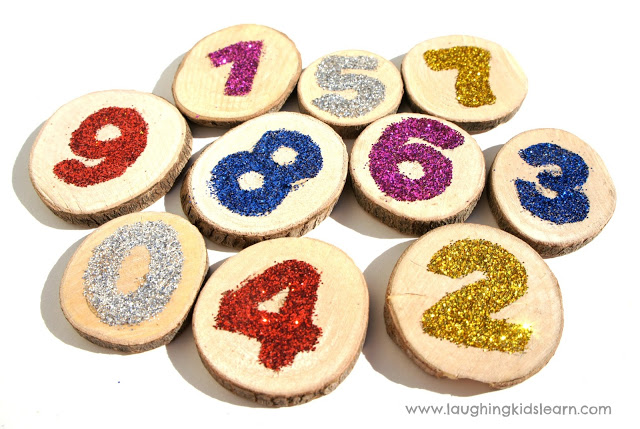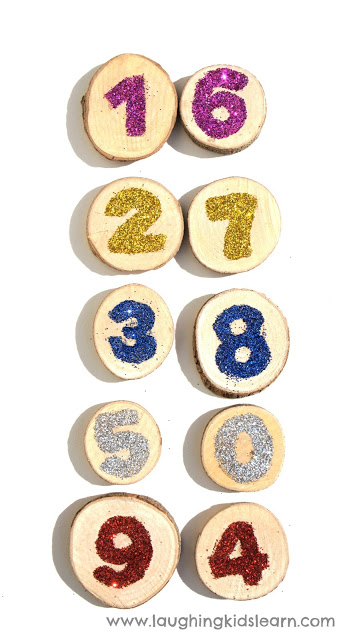Making the tools for learning
So lets just acknowledge for a second that I have decorated some pretty flash looking tokens using wooden discs, number stencils, a glue stick and some coloured glitter. This is not a priority for these games, just a simple idea you might like to try yourself.
Quite simply you might want to write 0 – 9 on 10 post-it notes. It works just as well.
Here are some simple (but fun) number games and activities you can simply do at home using objects/tokens that have been labeled 0-9.
Place tokens in a bag. Child draws out a number and provides its number name. Simple and perfect way to teach very young children.
Above and Below
Children draw a token from a bag and answer once they have applied a given rule. For example, the rule might be ‘two above, two below’. Child draws a number, they calculate what the number would be that’s two above and the number two below the number that was drawn out of the bag. Great for addition and subtraction skills.
What’s my Number?
Describe to a child the qualities or visual characteristics of a mystery number that you’re thinking of in your head. Children guess based on your descriptive clues.
Ordering
Child places the tokens in order from smallest to largest or vice versa.
Can you make?
Children use their understanding of addition to collect two or three tokens that add up to a number you chose. For example, the given number is 6 and the child finds 1, 3, 2 which add up to 6.
Odd or Even
Children to categorise the tokens into the numbers that are odd and those that are even. This can also be done when making larger numbers using more tokens.
Place Value (2 digits)
Use the tokens to make 5 sets of two digit numbers. Child is to order them from the smallest value to the largest or vice versa. (see above)
Head or Tails
Children can flip the ‘0’ token and record data, counting how many heads appear (as the 0 face) compared to the number of tails. Children can make predictions prior to discovering the results.
Flip It!
Children make a 2, 3, 4, 5 digit number using the tokens and read it aloud. Now reverse the order of the numbers and read it. Is it a larger or smaller number? eg. 234 flipped 432. Great for building an understanding of place value.
Combinations of 10
An important skill for children to know, ask them to two tokens to make as many combinations that make 10 as possible. Children can also be asked to use more than two counters as extension.
Difference between
Depending on mathematical understanding, children draw out two tokens and calculate what the difference is between these numbers. For older children, they may draw out more tokens to make larger numbers and calculate averages.
What’s the chances of…
Discuss percentages and chance or possibility. Add tokens to a bag and ask them what the chances are that a 6 will be drawn out of the bag etc. If you have colour coded your tokens then you might focus on the colour of the numbers instead.
Patterning
Create the beginning or end of a number pattern and ask them to fill in the gaps.
Here are some more great maths ideas from some very talented bloggers.
* Fun Ways to Measure Outdoors – Wildlife Fun 4 Kids
* Strawberry Counting Cards – Boy Mama Teacher Mama
* Length Measuring with Play Doh – Learn with Play at Home
* 10 Scared Fish – My Little Bookcase
* Bottle Top Numbers – Octavia and Vicky













[…] Paint DIY Multicoloured Chalk How to Make Crystals Painting with Kitchen Cleaners Number Games & Activities for Kids Bubble Painting for Toddlers Mess Free Painting for Toddlers LEGO Activity for Tots […]